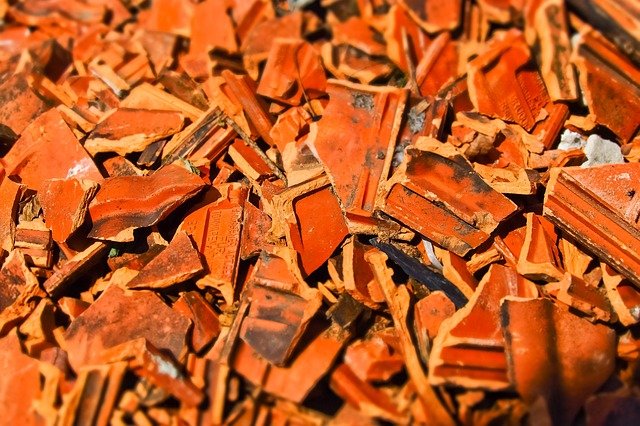Why is it not possible to reassemble pieces of a broken solid?

Credits: Pixabay
How is it that two pieces of a broken solid object cannot be bound back together without using some type of adhesive?
This may sound like an absurd question to ask as we would never expect broken objects to be put back into one piece without the use of glue, stick or similar.
But when you dig deeper into this topic, it raises interesting questions about what makes atoms within a solid bond together.
Let's take the example of a simple object made of a single type of atoms: a strip of lead.
The lead atoms within the strip are locked together in a fixed framework which gives the object its rigidity.
When the strip is cut into two pieces, what happens to the atoms at the point of separation?
Why is it that the only way to fuse the two parts together ever again is to melt the edges, reassemble the pieces and wait for it to cool down?
How is inter-atomic bond achieved within a solid?
What happens when the solid is liquefied, then solidified again?
StemQ Notice: This post was originally submitted on StemQ.io, a Q&A application for STEM subjects powered by the Steem blockchain.
This post has been voted on by the SteemSTEM curation team and voting trail.
If you appreciate the work we are doing then consider voting us for witness by selecting stem.witness!
For additional information please join us on the SteemSTEM discord and to get to know the rest of the community!
As far as I remember the problem is twofold:
You cannot make an absolutely straight cut. The surfaces might look flat but on the microscopic level there are big irregularities which does not allow atoms to get close enough to each other to stick into one piece.
There is air in between which also prevents atoms of the solid pieces from jouning togetger. Moreover, oxygen interacts with those atoms creating a thin irregular layer of oxide on top, which creates another obstacle.
If you manage to make two absolutely flat bricks and join them together in vacuum, they will stick into one piece.
There was a video of Richard Feynman describing this phenomenon in the context of friction. But unfortunately I could not find it now. So I might be wrong after all.
It was actually in Feynman lectures:
"It was pointed out above that attempts to measure μ by sliding pure substances such as copper on copper will lead to spurious results, because the surfaces in contact are not pure copper, but are mixtures of oxides and other impurities. If we try to get absolutely pure copper, if we clean and polish the surfaces, outgas the materials in a vacuum, and take every conceivable precaution, we still do not get μ. For if we tilt the apparatus even to a vertical position, the slider will not fall off—the two pieces of copper stick together! The coefficient μ, which is ordinarily less than unity for reasonably hard surfaces, becomes several times unity! The reason for this unexpected behavior is that when the atoms in contact are all of the same kind, there is no way for the atoms to “know” that they are in different pieces of copper. When there are other atoms, in the oxides and greases and more complicated thin surface layers of contaminants in between, the atoms “know” when they are not on the same part. When we consider that it is forces between atoms that hold the copper together as a solid, it should become clear that it is impossible to get the right coefficient of friction for pure metals."
Thanks, this is very interesting.
Though the text falls short on telling that the two pieces of copper becomes one and cannot be separated without tools.
So the atomic framework at the point of contact between the two copper pieces is probably not the same as the atomic framework within each piece.
I think this part says almost exactly what you are looking for:
About 1, wouldn't the jagged edges just connect to the other jagged edges, leading precipitously to yet more connections, until the parts were whole again? .. So I'm leaning toward 2, if those are the only options!
Well, again, if you manage to fit them precisely in the proper places on the microscopic level, than yes. Also I suspect that many jags would be bended or broken while cutting.
But again, I'm not sure. It's just my guess.
Today I learned (fact #4) that solid pieces really join together in space. See cold welding. So you must be right, the main problem is 2.
@irelandscape
Congratulations @irelandscape! You have completed the following achievement on the Steem blockchain and have been rewarded with new badge(s) :
Click here to view your Board
If you no longer want to receive notifications, reply to this comment with the word
STOPTo support your work, I also upvoted your post!
Do not miss the last post from @steemitboard:
Hi, @irelandscape!
You just got a 2.12% upvote from SteemPlus!
To get higher upvotes, earn more SteemPlus Points (SPP). On your Steemit wallet, check your SPP balance and click on "How to earn SPP?" to find out all the ways to earn.
If you're not using SteemPlus yet, please check our last posts in here to see the many ways in which SteemPlus can improve your Steem experience on Steemit and Busy.